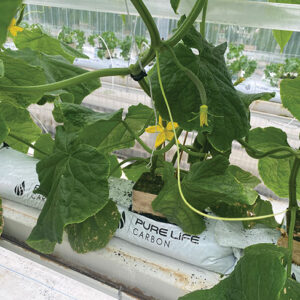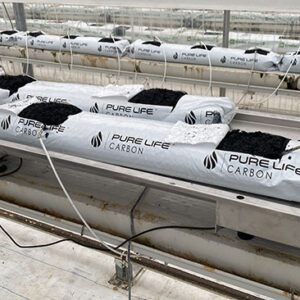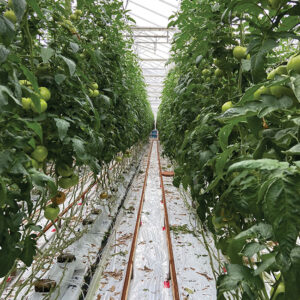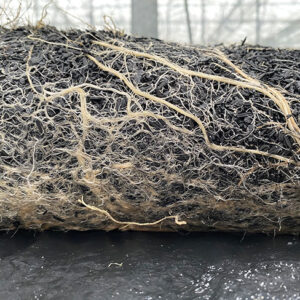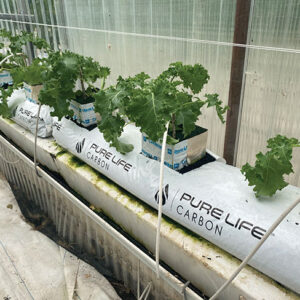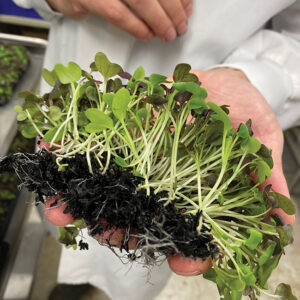
Features
Charged Carbon
This new stand-alone growing medium from Alberta’s Pure Life Carbon gains international interest
September 20, 2023 By Treena Hein
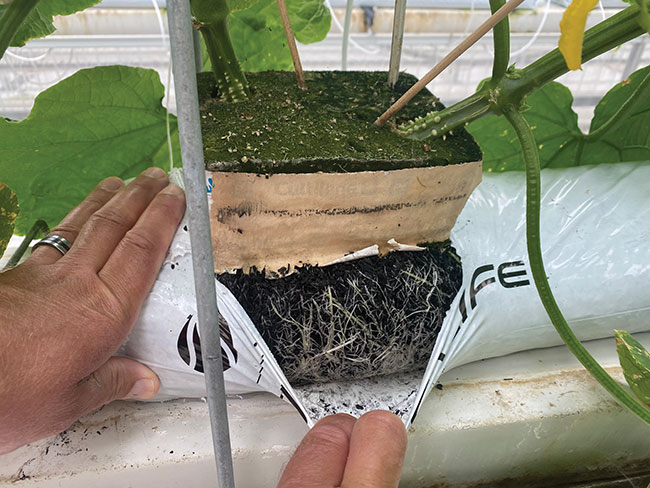 Charged Carbon is a standalone growing media that is reusable and sustainable.
PHOTOS: Pure Life Carbon
Charged Carbon is a standalone growing media that is reusable and sustainable.
PHOTOS: Pure Life Carbon Growing media is a critical component of greenhouse crop production, in terms of cost, but also sustainability and food safety, with contamination concerns on the rise across the industry. In addition, during the past two years due to supply chain issues and strong demand, availability of several media types was a serious issue for some growers in Canada and beyond. For all these reasons, new cost-effective, food-safe and sustainable media options are always welcome.
On the sustainability front, all conventional growing mediums are single use. Stonewool products, perlite and vermiculite must be landfilled. Peat is not renewable and can only be harvested in some areas of the world (indeed, it will be banned as a greenhouse growing medium in England and Ireland by 2030). Peat, bark, wood fibre and coconut fibre are compostable and all of those but peat are renewable, but must be shipped very long distances in some cases. And due to time, cost and space needed to compost at greenhouse sites, all these mediums tend to be landfilled.
‘Charged Carbon’ is a new product in a class all its own that’s both reusable and sustainable, with the feedstock being crops or trees. It hit the market in 2022, launched by Pure Life Carbon (PLC) of Alberta after an enormous amount of R&D to develop the product and scale up its manufacture. It’s the only standalone carbon growing media so far available on the global market. Its manufacture starts with a specific type of bamboo biomass being converted through multiple compounding steps including carbonization/pyrolysis and advanced chemical manipulation.
Its development was built on years of research done by Dr. Nick Savidov, a scientist currently at the Centre for Sustainable Food Production at Lethbridge College in Alberta. His work with carbon growing media began two decades ago, when he noted the investigations of colleagues into pyrolyzed carbon (charcoal) as a soil amendment for field crops. He also came across a paper from research outside Canada using pyrolyzed carbon in orchid production.
Savidov got samples from this group, worked on treatments to reduce alkalinity and did greenhouse experiments with impressive results.
Commercialization
PLC has invested more than $24 million to advance Dr. Savidov’s work, to create a scalable commercial process around their combined learnings and to do extensive additional testing. Before we look at test results however, it’s important to clarify the carbon product landscape.
PLC CEO Ryan Rand first notes that there are various products available intended for different end uses. “We as a company celebrate the range of these products, but while some of them function very well blended into other soilless substrates or as soil augmentations, not all of them do so,” he explains. “And our trademarked flagship product, Charged Carbon, is the only standalone carbon-based growing medium we are aware of anywhere around the world. We feel quite confident making that statement because we are in close contact with the greenhouse sectors in every country that has one. Unfortunately, there is quite a lot of confusion about products. What has become clear to us is that there was, and still is, a haphazard use of words to describe our product. It is being referred to by those in both academic circles and in some industry circles as biochar, black carbon, carbon black, bamboo carbon, charcoal, the list goes on. This is a really dangerous thing for greenhouse operators and for us, because we see them trying other products with results that put their businesses at risk and they then paint all products with the same negative brush.”
Similarly, Rand explains that the trademarked name ‘Charged Carbon’ is being used to describe other products that are being used in growing medium blends. “We hope that this article,” he says, “will clear up the confusion.”
Studies completed
At this point PLC has conducted over 50 commercial greenhouse trials throughout Europe and North America. The many large-scale industry partners involved in these studies cannot be named publicly, and most test results are private, but Rand can share some general results.
“These studies have proven Charged Carbon provides similar or better results in the main three yield parameters (number of vegetables/fruit, weight and consistency) for all the main greenhouse crops than coco, peat or stonewool,” he says. “Commercial tomato production result in higher Brix values compared to Grodan Rockwool in trials optimized for Grodan.”
In cucumber trials where seven litres of Grodan were used per plant (industry standard), much lower volumes of Charged Carbon (2.5, 3.5. 4.5 litres) all provided better performance in the three main yield parameters. Microgreens perform similarly on peat versus Charged Carbon at 50 per cent of the peat volume. Rand adds that “spinach germinates and grows well on Charged Carbon, which is a crop most of the industry struggles to grow at scale. I can provide more detailed results for growers who contact us and are partnership candidates.”
The most recent study is occurring at the renowned Vineland Research and Innovation Centre in southern Ontario (an independent organization supported partly by federal/provincial funding with research on greenhouse, vineyard and horticulture crops). “We were not involved at all in this study,” says Rand, “and although the details will not be published until October or so, we can say that the results are incredibly promising for year-round cucumber production. In the off-season, compared to standard Grodan Rockwool, cucumbers on three different volumes of Charged Carbon substantially outperformed, with the fertigation schedule optimized for Grodan. The next round of studies will compare Charged Carbon with all other growing media, with fertigation optimized for each.”
As mentioned, Charged Carbon can be re-used, but must undergo the ‘ReCharging’ process. “The ReCharged Charged Carbon performs as well as or better than first-use Charged Carbon,” says Rand. “Because of this aspect of our product, we actually lease it to growers and don’t sell it. This results in less cost for growers than using other media per crop cycle. We drop off new product and pick up used product for ReCharging. During this process, the Charged Carbon is analyzed and the root mass is separated and used as animal feed or composted. The Charged Carbon is cleaned of contaminants, sterilized and then sent out for extensive testing by a third-party lab to confirm there are no contaminants present. Then the ReCharged Charged Carbon is certified, assigned a batch number, packaged and sent back out into use.”
Market expansion
In December 2021, PLC raised $13 million in investment, enabling it to build its first 40,000 sq.-ft. production facility in Red Deer County, Alta. Here, 10,000,000 litres of Charged Carbon can be produced per year.
“We’re now in the process of finalizing sales with some of the very largest and most-reputable growers in North America and around the world,” Rand reports. “In June, we had an incredibly successful launch at ‘Indoor Agtech’ in New York city. We are also seeing a profound amount of interest in our product from growers in Europe because, as mentioned, the use of peat moss will not be permitted anymore starting in 2030 in some countries and growers close to these regions know its just a matter of time before that spreads to their countries as well. These growers are desperate for a sustainable and scalable product to maintain current production levels and to further expand. It appears that peat use for greenhouse production will be a focus to ban globally as new growing mediums are better alternatives for production and sustainability.”
Serving these markets means that Rand and his team will continue to educate growers about the differences between products intended for blending and standalone Charged Carbon.
“We fully understand that that some growers have tried a pyrolyzed carbon product and have had poor results and they are therefore wary of trying any other carbon products,” he says. “We will encourage them to try our product by showing them the extensive study results. We are very excited to be offering greenhouse operators a new growing medium option at a time when margins are razor thin and more sustainability is required across all types of food production. We think that greenhouse, indoor vertical farming and aquaponics will all expand, and that depends on having sustainable, cost-effective, food-safe growing mediums. Future food security depends on it.”
Print this page
